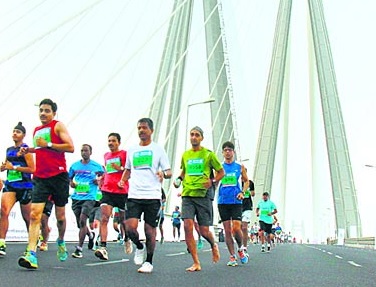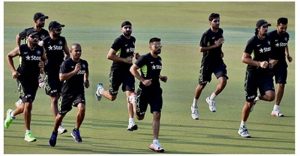
Running in India is becoming big, and sports related businesses are more than happy with the development, with fitness enthusiasts spending on fancy kits, sports shoes, apparels, and more. Many also feel that running is the new Golf now, providing business opportunities for businessmen and celebs.
No wonder, even small towns in India now want to organize marathons for the locals. Not just metros and mini-metros, but even smaller towns and districts want to host marathons now.
And all this has happened in the last few years; with the running craze in India starting in 2004 with the Standard Chartered Mumbai Marathon (SCMM). Today, hundreds of running races take place in India round the year.
Mumbai enjoys a geographical advantage by virtue of being a linear city (the running route is free of monotonous loops) and can rightfully boast being the most popular marathon destination in the country. The SCMM is Asia’s largest annual sporting event by number of participants.
Organising a Marathon
Organising a marathon is no less challenging than running one, at least in terms of preparation. Organisers have to liaise with several government departments for approvals for the route, timers and traffic control, among other requirements. The challenges peak on race day. At the recent Mumbai marathon, more than 40,000 apples, an equal number of sandwiches, and nearly 40,000 litres of water were distributed.
The costs involved are barely covered by the registration fees, even after the yearly increases. But that is not dampening the spirit of organisers because runners are turning up in big numbers.
The Indian runner is certainly pampered. Apart from the [identification] bib, every participant wants a medal, certificate, photographs, timing chip, water stations and a meal after the race. International races are nothing like this, he insists, pointing out that some even require runners to bring their own water.
From the list of races that crowd the weekend calendar round the year, shorter runs are the most popular and bring in the most money. Most of the corporate and other niche events, including Pinkathon, are under 3-10 km.
Getting Sponsors
To cover additional costs, organisers depend heavily on sponsors. As a marathon is very different from, say, cricket or football, as the participant is also a spectator here, the organisers are selling it differently. “In a marathon, there is 2.5 lakh sq ft of branding possible. I ask companies to look at it from the point-of-sweat perspective,” says an organiser, referring to the running route.
For instance, at the Mumbai marathon, Nestlé was the ‘nutritional partner’ and positioned itself at the water stations along the running route. And pain relieving balm Volini was the ‘recovery partner’, so runners ended the race, in joy and some pain, surrounded by Volini posters.
The organisers even hard sell the bib distribution event, which can potentially attract thousands of footfalls as runners arrive to collect their kits. Ahead of the Chennai marathon, the bib distribution was timed together with a health and fitness expo.
“Marathons have become the largest single source for charity raising in the country.”
Great for Business?
It helps the running industry that marathon is the new golf, a networking opportunity that brings together the crème de la crème of customers — from Reliance honcho Anil Ambani and TCS chief N Chandrasekaran to Bollywood stars Katrina Kaif, John Abraham and Milind Soman. Additionally the races also tug at your heartstrings, with their share of philanthropy. Runners can top their registration fee with a donation to charity; some organisers set aside a part of the race proceeds for a cause.
“Once you are assured of a mega sponsor for, say, three or five years, it helps in building the run as a property and attract other sponsors,” explains a marathon organiser.
On the flip side, the marathon boom has serious runners worried about misplaced zeal and priorities — more than love for the sport, the focus seems increasingly on creating records. “Everyone is besotted by numbers, and everyone wants to create a record,” says another organiser.
Already Getting Crowded?
Although we are only seeing the tip of an iceberg in terms of the running industry, several marathons have sprung up in the country, and as competition becomes stiff, some of these events will eventually drop off.
Most running event organisers find it difficult to find sponsors initially and have to spend from their pockets. Once the word of mouth spreads and exposure is created through documentaries in various channels, one can expect to get the backing of sponsors.
Runners Can Aim Bigger
Mumbai marathon is accredited by the Association of International Marathons and Distance Races, and serves as qualifiers for the prestigious Boston Marathon. A runner in the Mumbai Marathon who finishes under the fixed time can run in Boston. Accreditation has sparked off greater competitiveness among the organisers, as runners have become selective.
Spawning an Industry
Most organisers not only arrange runs for clients but also set up running groups, and conduct workshops for schools and corporate houses on leadership, health and productivity development.
“We hold a run on the Formula 1 track in Noida, and the winners get to test drive vehicles of brands sponsoring the race. It is a great marketing opportunity,” says an organiser in Noida.
Running is indeed spawning an industry and has gone beyond just being a cool sport. People now have four to five pairs of running shoes. They are concerned about issues such as hydration, or about recovery after a race. You may not know but a runner could easily be wearing gear worth Rs.50,000.
City administrators are slowly waking to the popularity of marathons and how they can benefit the local economy. Studies in the US have shown that when affluent participants converge to run, it can result in an estimated $200 million windfall for the host city. At nearly 40,000 participants, the SCMM certainly means business for its organiser — especially those in the hospitality and transport sectors.
India too is gearing up to capitalize on the running industry — a sector that many see as recession-proof too!









Leave a Reply